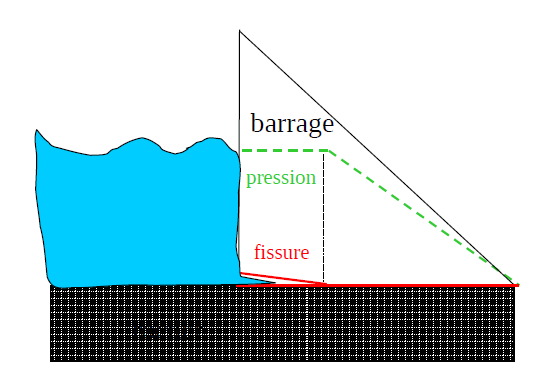5. Taking into account hydrostatic pressure without coupling#

Figure 5-1: Illustration of a possible calculation of the stability of a dam with the imposed pressure profile
Although modeling XXX_JOINT does not couple mechanics and hydraulics, we can however explicitly introduce the influence of a fluid on mechanics via an imposed pressure. The presence of fluid in the joint changes the normal mechanical stress \({\sigma }_{n}\to {\sigma }_{n}-p\). By applying significant pressure, it is possible to cause the joint to break by a simple hydraulic effect. To take into account hydrostatic effects, the mechanical law is offset downward (Figure) according to the pressure value \(p\) at each integration point.
The numerical implementation is easy in case of complete writing of mechanical laws in explicit non-incremental form as a function of displacements and internal variables (it is necessary to exclude the dependence of the constraints at the moment plus as a function of constraints at the previous moment). In this case, the only modification of the normal curve is sufficient to introduce the coupling:
: label: eq-61
{sigma} _ {n}mathrm {=} {sigma} _ {sigma} _ {n} ^ {mathit {meca}} ({delta} _ {n}, {delta} _ {t})mathrm {-} p
By limiting ourselves to this type of physical phenomenon, it is possible to carry out studies where the pressure profile is imposed by user, for example a dam stability study under a conservative hypothesis (Figure), that is to say in the presence of underpressure, whose shape is very penalizing. In order to make a calculation with an imposed pressure, the user must define a function, using the keyword PRES_FLUIDE, which depends both on space (non-homogeneous pressure profile) and on time (evolution of the pressure profile).
By limiting ourselves to this type of physical phenomenon, it is possible to carry out studies where the pressure profile is imposed by user, for example a dam stability study under a conservative hypothesis (Figure), that is to say in the presence of underpressure, whose shape is very penalizing. In order to make a calculation with an imposed pressure, the user must define a function, using the keyword PRES_FLUIDE, which depends both on space (non-homogeneous pressure profile) and on time (evolution of the pressure profile).